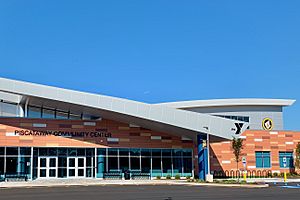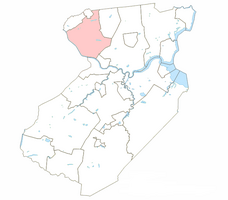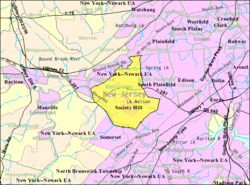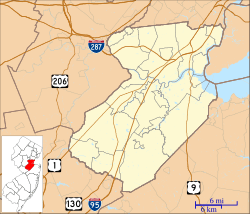Piscataway, New Jersey facts for kids
Quick facts for kids
Piscataway, New Jersey
|
||
|---|---|---|
|
Township
|
||

The YMCA at the Community Center
|
||
|
||
| Motto(s):
A Proud Diversified Community
|
||

Location of Piscataway Township in Middlesex County highlighted in pink.
|
||

Census Bureau map of Piscataway Township, New Jersey
|
||
| Country | ||
| State | ||
| County | Middlesex | |
| Formed | October 31, 1693 | |
| Incorporated | February 21, 1798 | |
| Government | ||
| • Type | Faulkner Act Mayor-Council | |
| • Body | Township Council | |
| Area | ||
| • Total | 18.96 sq mi (49.11 km2) | |
| • Land | 18.79 sq mi (48.68 km2) | |
| • Water | 0.17 sq mi (0.43 km2) 0.88% | |
| Area rank | 149th of 565 in state 7th of 25 in county |
|
| Elevation | 52 ft (16 m) | |
| Population
(2020)
|
||
| • Total | 60,804 | |
| • Estimate
(2023)
|
60,944 | |
| • Rank | 25th of 565 in state 4th of 25 in county |
|
| • Density | 3,235.3/sq mi (1,249.2/km2) | |
| • Density rank | 206th of 565 in state 16th of 25 in county |
|
| Time zone | UTC−05:00 (Eastern (EST)) | |
| • Summer (DST) | UTC−04:00 (Eastern (EDT)) | |
| ZIP Codes |
08854, 08855
|
|
| Area code(s) | 732 and 908 | |
| FIPS code | 3402359010 | |
| GNIS feature ID | 0882167 | |
Piscataway (/pɪˈskætəweɪ/ PIH-skat-Ə-way) is a township in Middlesex County, New Jersey. It's a suburb of the New York metropolitan area, located in the Raritan Valley. In 2020, about 60,804 people lived here. This was an increase of 8.5% from 2010.
The name "Piscataway" might come from early European settlers. They came from an area near the Piscataqua River between New Hampshire and Maine. That river's name means "branch" and "tidal river." Another idea is that it comes from a Lenape language word meaning "great deer" or "dark night place."
Piscataway Township was first formed on December 17, 1666. It became an official township on February 21, 1798. It is the fifth-oldest town in New Jersey. Over time, parts of Piscataway were used to create other towns. These include Edison, Dunellen, Middlesex, and South Plainfield.
Rutgers University has a large part of its main campus in Piscataway. This includes SHI Stadium, where the Rutgers Scarlet Knights football team plays. Part of the Robert Wood Johnson Medical School is also here.

Contents
History of Piscataway
Early Settlers and Town Formation
The first people to live in this area were the Lenape Native Americans. In 1666, four European settlers from New Hampshire bought about 40,000 acres of land from them.
In the same year, Governor Philip Carteret gave 12 new settlers from Massachusetts a large piece of land. This land later became Piscataway and Woodbridge. These settlements were started by people seeking religious freedom. They were leaving strict Puritan colonies in New England.
More settlers came from the Piscataqua River area in New Hampshire. They were mostly Baptists and Quakers. They were used to living in the wilderness and were looking for a new life. These pioneers had explored the land and waterways before settling. They also signed 12 "Articles of Agreement" with Governor Carteret. These rules helped create a democratic government for Piscataway and Woodbridge. They gave new families freedom and land ownership.
Growth and Development of the Township
By 1685, Piscataway and its surrounding areas covered about 40,000 acres. The Lenape Native Americans were gradually moved out as more European settlers arrived. The Lenape had created trails that the settlers then used for travel. Many of these old trails became the main roads we use today.
Piscataway Township is one of the oldest towns in New Jersey. It is also among the fifty oldest towns in the entire United States.
During the American Revolutionary War, a battle took place here. On February 8, 1777, the Battle of Quibbletown happened. British and Hessian troops fought against local patriot militias.
Camp Kilmer's Role in History
Camp Kilmer was a large military base built in 1941. It covered about 1,500 acres in Piscataway and Edison. It opened in 1942 and was used by the United States Army.
During World War II, it was a main place for soldiers to prepare before going overseas. It processed over 2.5 million soldiers. After the war, it helped process 30,000 refugees from the 1956 Hungarian Revolution. Camp Kilmer officially closed in 2009.
Geography and Location
Where is Piscataway Located?
Piscataway Township covers about 18.96 square miles (49.11 square kilometers). Most of this is land, with a small amount of water.
The township is on the south side of the Raritan Valley. This area includes other cities like New Brunswick and South Plainfield. Piscataway is about 45 minutes southwest of New York City. It is also about 53 minutes northeast of Philadelphia.
Neighboring Towns and Communities
Piscataway shares borders with nine other towns. These include Dunellen, Edison, Highland Park, Middlesex, New Brunswick, and South Plainfield in Middlesex County.
It also borders Franklin Township and South Bound Brook in Somerset County. Finally, it borders Plainfield in Union County.
Piscataway has several smaller communities and neighborhoods within it. Some of these are Arbor, Lake Nelson, New Market, and Randolphville. The original settlement of Piscatawaytown is now part of Edison.
The New Market area was once known as Quibbletown. Its name came from early settlers who "quibbled" (argued) about whether Sunday or Saturday should be the day of rest.
Economy and Businesses
Major Companies in Piscataway
Piscataway is home to many important companies. These businesses provide jobs and help the local economy.
Some of the companies located here include:
- American Standard Brands
- Colgate-Palmolive (Research and Development)
- GenScript Biotech
- Hapag-Lloyd America (an international shipping company)
- IEEE (Institute of Electrical and Electronics Engineers)
- Johnson & Johnson Health Care Systems Inc.
- Pepsi Cola Bottling Group (a bottling plant)
- Siemens Hearing Instruments (a large hearing aid maker)
The world headquarters of Telcordia Technologies used to be in Piscataway. This company was bought by Ericsson in 2011.
Sports and Athletics
Sports Venues at Rutgers University
Piscataway is a hub for sports, especially because of Rutgers University.
SHI Stadium was built in 1994. It has 41,500 seats and is the home field for the Rutgers Scarlet Knights football team. It was expanded in 2009 to hold over 52,000 people.
The Louis Brown Athletic Center is where the Rutgers University men's and women's basketball teams play. It can hold 9,000 people. Many still call it the RAC. The professional New Jersey Nets basketball team played here from 1977 to 1981.
Yurcak Field is a stadium for soccer and lacrosse. It was built in 1994 and holds 5,000 people. It's named after Ronald N. Yurcak, a former Rutgers lacrosse player.
Emergency Services
Fire and EMS Services
Piscataway has four fire districts. These districts are served by volunteer fire companies and rescue squads.
There are two volunteer rescue squads and six volunteer fire companies. One company, North Stelton Fire Rescue EMS, provides both fire and ambulance services. During weekdays and some weekends, Hackensack Meridian Health EMS also provides ambulance service.
When volunteers are not available, other services like Rutgers University Emergency Services or Robert Wood Johnson University Hospital may send an ambulance.
Police Protection
The main police force in Piscataway is the Piscataway Police Department. The Rutgers University Police Department also works on the university campuses here. The New Jersey State Police patrol Interstate 287, which runs through the township.
Education in Piscataway
Public Schools for All Ages
The Piscataway Township Schools serve students from pre-kindergarten through high school. In the 2018–19 school year, there were 10 schools and over 7,100 students.
The district has:
- Four elementary schools for grades K–3: Dwight D. Eisenhower, Grandview, Knollwood, and Randolphville.
- Two intermediate schools for grades 4–5: Arbor and Martin Luther King.
- Three middle schools for grades 6–8: Conackamack, Quibbletown, and Theodore Schor.
- One high school for grades 9–12: Piscataway High School.
County and Special Schools
Students from all over Middlesex County can apply to special high school programs. These are offered by the Middlesex County Vocational and Technical Schools. They provide career and technical education.
Some of these schools are in Edison, Woodbridge, East Brunswick, Perth Amboy, and Piscataway. There is no tuition fee for students to attend.
Other special schools in Piscataway include:
- Nuview Academy Piscataway Campus: For students with depression, ADHD, or anxiety.
- Bright Beginnings Learning Center: For students with Autism.
- Piscataway Regional Day School: Also for students with Autism.
- Raritan Valley Academy: For students with behavioral or learning disabilities.
Private Schools and Colleges
Piscataway also has private schools:
- Lake Nelson Seventh-day Adventist Academy: For students from Pre-K to tenth grade.
- Timothy Christian School: A K–12 school founded in 1949.
- An-Noor Academy: A Pre-K–12 school for the Muslim community.
For higher education, Piscataway is home to parts of Rutgers University. This includes the Busch and Livingston Campuses. There are also other specialized centers like the Center for Advanced Biotechnology and Medicine.
Transportation and Roads
Major Roads and Highways
Piscataway has many roads and highways. As of 2010, there were over 206 miles of roadways. Most of these are maintained by the township.
Interstate 287 goes through Piscataway. It has several exits (6, 7, 8, and 9) within the township. The River Road (CR 622) Bridge over Interstate 287 was rebuilt in 2024.
Other important roads include CR 501 and CR 529. Route 18 also runs along Hoes Lane to Interstate 287.
You can also easily reach the New Jersey Turnpike (Interstate 95) from Piscataway. It has exits in nearby East Brunswick and Edison.
Public Transportation Options
NJ Transit provides bus service for residents. You can take buses to Port Authority Bus Terminal in Midtown Manhattan (route 114). Buses also go to Newark (routes 65 and 66). There is also local bus service (route 819).
Piscataway does not have its own train station. However, train service is available nearby. You can catch the Raritan Valley Line at the Dunellen station. The Northeast Corridor line is available at the Edison station.
Taiwanese airline EVA Air offers a private bus service. This service takes customers from New Jersey to John F. Kennedy International Airport in New York City. This bus service stops in Piscataway.
Places to Visit
Piscataway has several interesting places to explore:
- WVPH: This is the community radio station for Piscataway High School and Rutgers University.
- Metlar-Bodine House: This museum tells the story of Piscataway's history. It is in a house that dates back to 1728.
- Cornelius Low House: Built in 1741, this house is now a Middlesex County Museum.
- East Jersey Old Town Village: Located in Johnson Park, this village has 16 historic homes. These homes were moved and rebuilt here to show what farmhouses in the area looked like long ago.
Notable People from Piscataway
Many interesting people have lived in or are connected to Piscataway. Here are a few:
- Mike Alexander (born 1965), a former NFL wide receiver.
- Melissa Bacelar (born 1979), a horror film actress.
- Marvin Booker (born 1990), an NFL linebacker.
- John Celestand (born 1977), a basketball player drafted by the Los Angeles Lakers.
- Mark Ciardi (born 1961), a film producer and former Major League Baseball pitcher.
- Anthony Davis (born 1989), an offensive tackle for the San Francisco 49ers.
- Malcolm Jenkins (born 1987), a safety for the New Orleans Saints.
- Asjha Jones (born 1980), a WNBA basketball player.
- Lisa Marie (born 1968), an actress who appeared in Planet of the Apes.
- Matt Nagy (born 1978), a former head coach of the Chicago Bears.
- Paul Rudnick (born 1957), a playwright and novelist.
- Bob Smith (born 1947), a New Jersey State Senator and former mayor of Piscataway.
- Karl-Anthony Towns (born 1995), an NBA basketball player for the Minnesota Timberwolves.
- Eric Young Jr. (born 1985), a former Major League Baseball player.
Images for kids
-
Reconstructed River Road (CR 622) Bridge over Interstate 287, exit 9, completed in 2024
See also
 In Spanish: Municipio de Piscataway para niños
In Spanish: Municipio de Piscataway para niños






